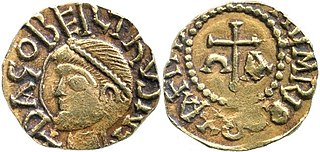Related Research Articles

Pepin II, commonly known as Pepin of Herstal, was a Frankish statesman and military leader who de facto ruled Francia as the Mayor of the Palace from 680 until his death. He took the title Duke and Prince of the Franks upon his conquest of all the Frankish realms.

Austrasia was a territory which formed the north-eastern section of the Kingdom of the Franks from the 6th to 8th centuries, ruled by the Frankish Merovingian and Carolingian dynasties during the Early Middle Ages. It was centred on the Meuse, Middle Rhine, and the Moselle rivers, and was the original territory of the Franks, including both the so-called Salian Franks and Ripuarian Franks, which Clovis I, King of the Franks (481–511) conquered after first taking control of the bordering part of Roman Gaul, which is sometimes described in this period as Neustria.

Dagobert I was King of the Franks. He ruled Austrasia (623–634) and Neustria and Burgundy (629–639). He has been described as the last king of the Merovingian dynasty to wield real royal power. Dagobert was the first Frankish king to be buried in the royal tombs at the Basilica of Saint-Denis.

Chlothar II, sometime called "the Young", was king of the Franks, ruling Neustria (584–629), Burgundy (613–629) and Austrasia (613–623).

Neustria was the western part of the Kingdom of the Franks during the early middle ages, in contrast to the eastern Frankish kingdom, Austrasia. It initially included land between the Loire and the Silva Carbonaria, in the north of present-day France, with Paris, Orléans, Tours, Soissons as its main cities. The population was therefore originally largely Romanised.

The Carolingian dynasty was a Frankish noble family named after Charles Martel and his grandson Charlemagne, descendants of the Arnulfing and Pippinid clans of the 7th century AD. The dynasty consolidated its power in the 8th century, eventually making the offices of mayor of the palace and dux et princeps Francorum hereditary, and becoming the de facto rulers of the Franks as the real powers behind the Merovingian throne. In 751 the Merovingian dynasty which had ruled the Franks was overthrown with the consent of the Papacy and the aristocracy, and Pepin the Short, son of Martel, was crowned King of the Franks. The Carolingian dynasty reached its peak in 800 with the crowning of Charlemagne as the first Emperor of the Romans in the West in over three centuries. His death in 814 began an extended period of fragmentation of the Carolingian Empire and decline that would eventually lead to the evolution of the Kingdom of France and the Holy Roman Empire.

Childebert II (c.570–596) was the Merovingian king of Austrasia from 575 until his death in March 596, as the only son of Sigebert I and Brunhilda of Austrasia; and the king of Burgundy from 592 to his death, as the adopted son of his uncle Guntram.

Childeric II was a King of the Franks. He ruled Austrasia from 662 and Neustria and Burgundy from 673 until his death, making him sole king for the final two years of his life.

Ebroin was the Frankish mayor of the palace of Neustria on two occasions; firstly from 658 to his deposition in 673 and secondly from 675 to his death in 680 or 681. In a violent and despotic career, he strove to impose the authority of Neustria, which was under his control, over Burgundy and Austrasia.

The Kingdom of the Franks, also known as the Frankish Kingdom, the Frankish Empire or Francia, was the largest post-Roman barbarian kingdom in Western Europe. It was ruled by the Frankish Merovingian and Carolingian dynasties during the Early Middle Ages. Francia was among the last surviving Germanic kingdoms from the Migration Period era.

Dagobert II was a Merovingian king of the Franks, ruling in Austrasia from 675 or 676 until his death. He is one of the more obscure Merovingians. He has been considered a martyr since at least the ninth century.

Theuderic III was King of the Franks. He ruled Neustria and Burgundy on two occasions, as well as Austrasia from 679 to his death in 691.

Alamannia, or Alemannia, was the kingdom established and inhabited by the Alemanni, a Germanic tribal confederation that had broken through the Roman limes in 213.

Sadalberga was the daughter of Gundoin, Duke of Alsace and his wife Saretrude. Sadalberga founded the Abbey of St John at Laon. She is the subject of a short hagiography, the Vita Sadalbergae.
The Duchy of Alsace was a large political subdivision of the Frankish Empire during the last century and a half of Merovingian rule. It corresponded to the territory of Alsace and was carved out of southern Austrasia in the last decade of the reign of Dagobert I, probably to stabilise the southern reaches of Austrasia against Alemannia and Burgundy. By the late Middle Ages, the region was considered part of Swabia.

Adalrich, also known as Eticho, was the Duke of Alsace, the founder of the family of the Etichonids and of the Habsburg, and an important and influential figure in the power politic of late-seventh-century Austrasia.
The Etichonids were an important noble family, probably of Frankish-Burgundian origin, who ruled the Duchy of Alsace in the Early Middle Ages. The dynasty is named for Eticho, who ruled from 673 to 690.
Waldalenus, or Wandalenus, dux in the region between the Alps and the Jura, in the Frankish Kingdom of Burgundy, was a Frankish magnate who served as mayor of the Austrasian palace at Metz from 581, during the minority of Childebert II.

The Battle of Lucofao was the decisive engagement of the civil war that afflicted the Frankish kingdoms during and after the reign of Dagobert II (676–79). In the battle, the Neustrian forces of Theuderic III and his majordomo Ebroin defeated the forces of Austrasia under the dukes Pippin and Martin.
Amalgar, also Amalgarius, was a Burgundian duke from the area around Dijon. He was also the proprietor of multiple monasteries, and was a progenitor of the Etichonid clan, from which the Habsburgs originate.